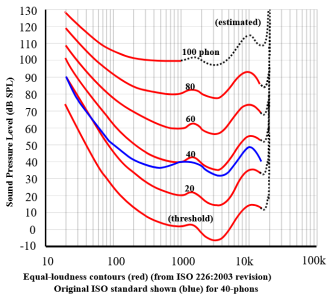Discipulus
New member
- Joined
- Dec 29, 2023
- Messages
- 2
The human ear can't hear bass or Treble very well at lower volumes. Thus, modern devices with DSP implement Equal Loudness EQ curves to make the perceived volume be the same across a wider range of frequencies at multiple volume levels.
This would be super helpful to implement in the WIIM side before sending to an AMP, as most folks don't have a loudness switch on modern amplifiers, or can't afford super expensive setups with DSP to accomplish this.
Right now I've optimized my setup for listening at about 80db. Lower volume than that, and it sounds thin and lacks bass. But if I optimize for 60db, then when I crank it up it sounds boomy. This is where Loudness mode comes in, to solve this problem. This is also why most bluetooth or smart speakers (such as Amazon Echo speakers) seem to sound so good at low volume - they use loudness and DSP to achieve a higher level of bass at low volumes and progressively less bass at higher volume to keep the same perceived volume.
Upvote if you want to see this feature in Wiim!
Wiki for reference: https://en.wikipedia.org/wiki/Equal-loudness_contour
This would be super helpful to implement in the WIIM side before sending to an AMP, as most folks don't have a loudness switch on modern amplifiers, or can't afford super expensive setups with DSP to accomplish this.
Right now I've optimized my setup for listening at about 80db. Lower volume than that, and it sounds thin and lacks bass. But if I optimize for 60db, then when I crank it up it sounds boomy. This is where Loudness mode comes in, to solve this problem. This is also why most bluetooth or smart speakers (such as Amazon Echo speakers) seem to sound so good at low volume - they use loudness and DSP to achieve a higher level of bass at low volumes and progressively less bass at higher volume to keep the same perceived volume.
Upvote if you want to see this feature in Wiim!
Wiki for reference: https://en.wikipedia.org/wiki/Equal-loudness_contour



